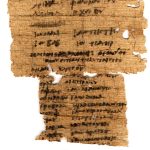| Artefact ID | 1697 |
| TM ID | TM 64300 |
| Findspot (DEChriM ID) | - () | Class | Textual |
| Material | Papyrus |
| Writing medium | Sheet/roll |
| Text content | Subliterary |
| Language | Greek |
| Description | P. Heid. 1 5, P. Heid. G 1359, PGM Christliches 14, van Haelst 1136: Onomasticum sacrum |
| Selection criteria | Christian terms/formulas/concepts, Christian onomastics |
| Date from | 300 |
| Date to | 399 |
| Dating criteria | Palaeography; the ed.pr. assigns the hand to the late 3rd/early 4th c. |
| Absolute/relative date | Relative date |
| Archaeological context | Unknown provenance; the Heidelberg papyrus collection was first established in 1897, purchased from Carl August Reinhardt. The papyri were recorded as having been found in the Fayyūm, Al-Ašmūnayn, Aḫmīm and al-Ǧabalain; this papyrus belongs to these. |
| Accession number | Heidelberg, Institut für Papyrologie P. G 1359 |


 Json data
Json data




